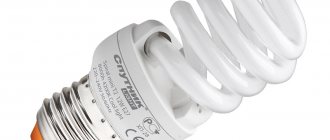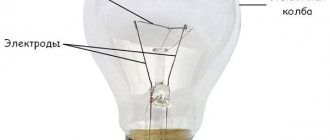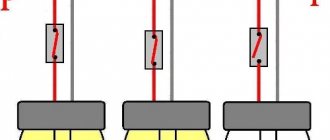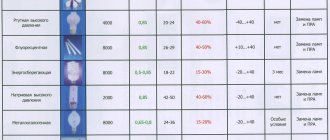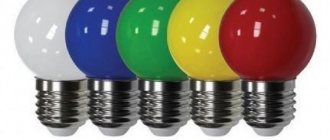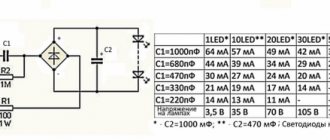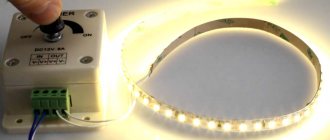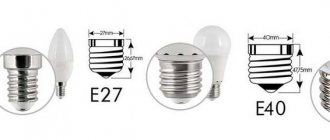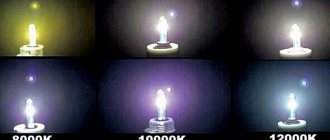Power ratio of different types of lamps
Progress does not stand still, and different types of lamps today can provide the same illumination, while expending completely different amounts of energy. Below we have provided a table for the most common types of lamps.
| Incandescent | Halogen | Energy Saver. | LED | Light flow |
| 40 W | 25 W | 9 W | 5 W | 400 lm |
| 60 W | 40 W | 12 W | 6 W | 700 lm |
| 75 W | 45 W | 15 W | 9 W | 900 lm |
| 100 W | 60 W | 20 W | 12 W | 1200 lm |
Of course, the power and illumination figures may vary depending on the specific manufacturer and even the lamp model (there are 12 W LED lamps with 1500-1600 lm), but this is approximately the ratio.
As you can easily see, in order to provide the same luminous flux, an LED lamp consumes approximately 8 times less energy.
To find out how many lamps you need for lighting, use our room illumination calculator.
Source
conclusions
In this article, we not only compared the power of LED lamps and incandescent lamps, but also figured out how to choose the right LED lamp. Do you understand what lumens and lux are? Will you be using LED lighting? or are you already using it? Write in the comments!
If you find an error, please select a piece of text and press Ctrl+Enter.
Related posts:
No related photos.
Rate this article:
( 1 ratings, average: 5.00 out of 5)
Tweet Pin It
about the author
admin
Administrator of te4h.ru, interested in new technologies, cryptocurrency, artificial intelligence, free software and Linux.
Brief characteristics of lamps on the market today
So LED lamps have taken their rightful place in our market. Their main advantage is significant energy savings. Energy-saving fluorescent lamps are gradually becoming a thing of the past. Well, we can only say about incandescent lamps and halogen lamps in order to mention that such lamps still exist, but the prospects for their use are rather doubtful. The main advantage of incandescent lamps remains their low cost, which “keeps them afloat.” Next, in order not to bore you with a lengthy description, we suggest taking a look at the table, which shows the main operational characteristics of the listed lamps.
How to choose the right lighting for a room?
I could compare the power of LED lamps and incandescent lamps right now, you would see what you need and that’s it. But I want you to not just choose a lamp, but to understand how it works. Knowing the lighting standards and the area of the room, we can choose exactly the LED lamp we need.
First, let's look at the illumination standards in lux per square meter:
| Room | Norma, Lk |
| Kitchen | 108 |
| Cabinet | 250 |
| Dining room | 54 |
| Living space | 54 |
| Desk | 434 |
| Bedroom | 54 |
| Bathroom | 54 |
| Garage | 108 |
| Reading room | 431 |
Based on what you already know, calculating the necessary lighting will not be difficult for you. Let's say we have a room 5 by 6 meters, we are going to relax in it, so let's take the illumination to 54. The area of the room will be 5 x 6 = 30 meters. We multiply the illumination by the area and get the number of Lumens. 54 times 30 is 1620 lumens or lm. All that remains is to find such an LED lamp or buy two of 800 lumens.
LED lightening
This was the most accurate and correct way to select the power of an LED lamp. But we can still focus on the power consumption of incandescent lamps or even LED lamps.
Comparison of power of LED lamps, CFL and incandescent lamps
When choosing a fluorescent (usually called energy-saving) or LED lamp, many buyers are guided by the inscription on the packaging indicating the power of an incandescent light bulb it can replace. But this approach is erroneous, since manufacturing companies often overestimate the technical indicators of their products.
So what is the right thing to do and what to pay attention to when choosing an LED lamp instead of a burnt-out fluorescent or incandescent lamp?
Power ratio between incandescent and LED lamps
As a rule, many sellers take advantage of their customers’ ignorance and sell them LED lamps that do not meet the required parameters. For example, they talk about a brightness of 800 lumens and state that it is considered analogous to a conventional 100 W incandescent lamp. If you do not understand the difference, then you need to read this article in its entirety and carefully review the ratio tables. We also recommend reading the article on how to choose an LED lamp, it will help you avoid making mistakes.
Table of correspondence between power and luminous flux
Unlike light bulbs with a spiral, the main selection criterion for which is power (W), you need to buy LED lamps based on luminous flux (lm). It is this physical quantity that indicates how much light power a particular light source emits. By the way, the packaging of all currently produced incandescent lamps also indicates the value of the luminous flux. The buyer just needs to learn how to correctly compare watts and lumens. And to make this task easier, below is a table of power and luminous flux for the three main types of lamps.
Differences in design and operating principle
For the first time, a patent was received for a light source with a tungsten filament by Russian scientist A.N. Lodygin in the 90s of the 19th century. Such lighting lamps operate on the principle of incandescent filament of a special tungsten alloy to very high temperatures, which inevitably leads to glow. Structurally, such a device consists of a glass flask with a chemically inert gas inside (for example, a mixture of nitrogen with argon), a tungsten filament (incandescent filament), molybdenum filament holders with other elements for holding the filament, and electrical conductors with a base at the bottom of the lamp.
Such lamps are widely used in all spheres of human activity, but are gradually being replaced by modern and efficient LED lighting devices.
LED lamps were discovered at the beginning of the 20th century, but were first used in practical use only in 1962, when an American scientist from the University of Illinois, Nick Holonyak, obtained crystals with a red glow. The principle of LED luminescence is based on the electric-hole junction characteristic of semiconductor elements. When electric current passes in the forward direction through the LED, photons are emitted and a glow appears.
With the development and improvement of technological processes, the production of LEDs has ceased to be expensive and LED lamps have become widespread, rapidly displacing incandescent lamps from the market. All this happens because such devices have a high efficiency and, at low power, have a high luminous flux.
Why such difference?
To answer this question, let's briefly look at the operating principle of each type of light bulb and compare their energy consumption. In an incandescent light bulb, the working element is a tungsten filament, which must be heated to 2000-3400°C to make it glow brightly. At the same time, approximately 95% of the lamp’s power consumption is spent maintaining the temperature of the coil, which means its efficiency will be only about 5%.
The operating principle of a compact fluorescent lamp (CFL) is to produce UV radiation by passing current through mercury vapor and then converting it into visible light using a phosphor layer. The energy efficiency of modern CFLs is approximately 5 times higher than their filament counterpart.
Power and light output
One of the important parameters of lighting devices is their light output. It is from this characteristic that you can understand how efficient a lighting device is and how much energy it consumes. Light output directly depends on two quantities: luminous flux and device power.
What is luminous flux?
Luminous flux is a quantity that shows the amount of light energy generated per unit of time. It is measured in lumens (denoted lm or lm). Device power is the amount of electrical energy that the device consumes and converts.
The luminous efficiency of lighting fixtures shows the ratio of luminous flux to lamp power. Incandescent lamps are outsiders in this characteristic and have a very low light output (this is due to the fact that power is spent not only on light radiation, but also on thermal radiation, and this, naturally, reduces the efficiency of the device). Perfect and high-quality LED products have a high luminous flux at low power, which increases the luminous efficiency many times.
Table 1. Comparative table of the ratio of luminous flux (lumens) to lamp power consumption (W) for LED lamps and incandescent lamps
| Power, W | Luminous flux, lm | |
| Incandescent | LED | |
| 25 | 3 | 255 |
| 40 | 5 | 430 |
| 60 | 9 | 720 |
| 75 | 11 | 955 |
| 100 | 14 | 1350 |
| 150 | 19 | 1850 |
| 200 | 27 | 2650 |
Summing up
The power of the LED lamp, when choosing, is not a paramount value. Much more important is the luminous flux it emits. The same point applies to energy-saving CFLs. If we take a more pedantic approach to replacing burnt-out artificial light sources with LED analogues, then in addition to comparing light fluxes, it is necessary to take into account the pulsation coefficient, color rendering index and a number of other points, described in detail in the article on choosing LED lamps. It is also recommended to pay attention to the design features of the lamp in which the light bulb will be used.
Source
LED lamp power table
The first table contains information about all LEDs with open diodes. The absence of a bulb increases brightness by 15-25% - take this into account. Read the review of the Feron LED lamp.
As you can see, the table is simple and not difficult to remember. When you purchase, just say the required light flow and power, the seller here will not be able to cheat in any way.
Draw your attention to! The table shows those lamps that come without a bulb. So if you think that a 10 W LED will be equal to a 100 W incandescent lamp, this is wrong. 20% of the brightness is lost because the driver begins to heat the bulb. As a result, instead of the declared 1300 lumens, we get only 800-900 lumens.
The bulb is considered an integral part; without it, LEDs cannot be used, because the light is blinding, almost like welding.
Related article: Modular sofa for a living room with a sleeper
If you are still wondering: How many lumens are in a 40, 100, 20 watt light bulb? You can easily answer this question. Read about how to increase the power of an LED lamp by 25%.
In order not to confuse you, we decided to make an approximate table. Looking at it, you will definitely understand the ratio of LED and incandescent power.
Power Correspondence Table
In everyday life, tungsten ones with a power of 40–100 watts are used. For analysis, compliance with these indicators of these LED lamps is carried out. The results are tabulated for LED and incandescent lamps:
| Incandescent lamp power, watt | LED power, watt | Average luminous flux, lm |
| 40 | 5 | 400 |
| 60 | 7 | 560 |
| 75 | 11 | 880 |
| 100 | 13 | 1040 |
| 150 | 20 | 1600 |
| 200 | 30 | 2550 |
| 300 | 40 | 3450 |
| 500 | 60 | 5200 |
The results show that the declared data of incandescent lamps correspond to the data of the LED source 8 times less. SL have an advantage, since the power consumption is less and the service life is longer.
Heat dissipation and service life
The operating temperature of Ilyich's light bulb is 180 degrees Celsius. In some cases, the glass flask can heat up to higher temperatures. This feature is by no means an advantage of an incandescent lamp; on the contrary, it is a significant disadvantage. After all, an ordinary light bulb can become a real source of fire.
It is not recommended to use incandescent lamps when installing electrical wiring in wooden houses.
Plus, it is sometimes difficult to unscrew such a lamp from the socket; sometimes it is completely necessary to resort to radical methods of freeing the bulb. LED wins in this regard. The glass bulb heats up no higher than 50 degrees Celsius, which makes them practically safe and suitable for lighting any room.
Comparison table between incandescent and LED lamps
A few words about the service life of two different lamps. According to the manufacturer, the LED can last about 45,000 hours, which is tens of times longer than the average lifespan of an alternative light source. This leads to one simple but very logical conclusion - it is better to buy an LED lamp once, which may last for several years, than to purchase outdated analogues every month.
